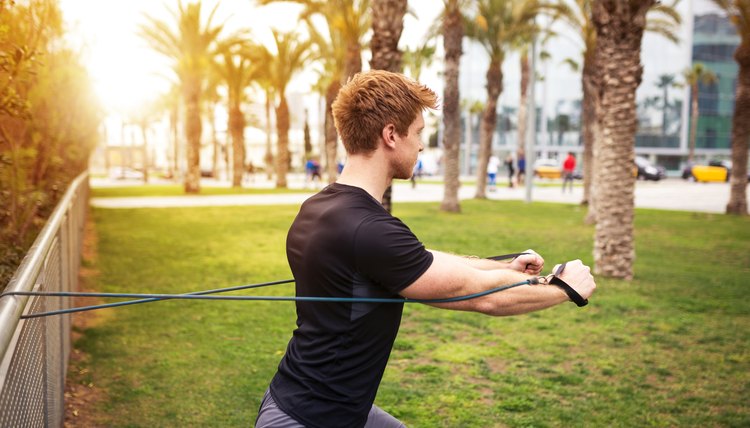Rockwood Shoulder Exercises

Subluxing or dislocating your shoulder can be a scary and painful experience. Rockwood shoulder exercises are designed to prevent the shoulder from continuing to come out of its socket. This strengthening routine targets the rotator cuff and deltoid muscles in an effort to give stability to the joint. Each of the five exercises targets a different muscle or group of muscles in your shoulder.
Read More: Dislocated Shoulder & Rehab Exercises

Rockwood shoulder exercises are one way to decrease the chances of your shoulder subluxing again.
Resisted Flexion
Resisted flexion activates the anterior deltoid muscle, which aides in stabilizing the front part of the shoulder joint.
To do this exercise, secure one end of a resistance band in a door and hold onto the other end with your back turned to the door. Keep your elbow bent at a 90-degree angle and by your side. Slowly extend your elbow as you lift your arm straight forward to shoulder level. This will cause the tension to increase in the band. Hold this position for 5 seconds before releasing the tension and returning your arm to the starting position. Do five repetitions of this exercise.

Rockwood shoulder exercises are one way to decrease the chances of your shoulder subluxing again.
Resisted Extension
This exercise strengthens the posterior deltoid muscle in the back portion of the shoulder joint.
Stand facing a door and hold onto a resistance band in one hand. The other end of the band should be secured in the door. Keeping your elbow bent at a 90-degree angle and resting at your side, step backwards until the band is pulled taut.
Pull your arm away from the door until it moves backwards by 45 degrees. Keep the arm in this position for 5 seconds before returning it to your side. Perform this exercise 5 times consecutively before taking a break.
Resisted External Rotation
This exercise strengthens the infraspinatus and teres minor. These rotator cuff muscles give stability to the shoulder and help prevent forward subluxation.
Stand with your right side away from a door. Bend your right elbow to 90 degrees and hold on to a resistance band with your palm facing inward. The other end of the band should be closed in the door.
Without allowing your elbow to leave your right side, slowly rotate your forearm 45 degrees away from the door. As you do this, squeeze your right shoulder blade down and back.
After a count of 5 seconds, release the band’s tension and return your forearm to its initial position. Complete 5 repetitions of this exercise.
Read More: Anterior Shoulder Instability Exercises
Resisted Shoulder Abduction
This exercise strengthens your supraspinatus, one of the four rotator cuff muscles. This muscle helps compress the shoulder joint to keep it in place.
With one end of a band in a door and the other in your right hand, stand with your left shoulder closest to the door. Your right elbow should be bent at a 90-degree angle and resting at your side. Keeping the elbow bent, move your right elbow away from your body by 45 degrees. Do not shrug your shoulder while you do this. Maintain this position for 5 seconds before returning the elbow to your side. Perform 5 repetitions.
Resisted Internal Rotation
This exercise strengthens the internal rotator muscles which provide stability to the front of the shoulder joint.
Fasten the end of a resistance band in a door and hold the other end in your right hand. Stand with your right side facing the door and your elbow bent at a 90-degree angle. Your right palm should face inward.
Keep your right elbow against your side and rotate your forearm away from the door towards your stomach. Once you reach your abdomen, maintain the hold for 5 seconds before rotating the arm back to the starting position. Complete the exercise 5 times before taking a break.
Warnings and Precautions
To improve shoulder stability, it is recommended you complete each Rockwood exercise two to three times daily. Begin with a light resistance band and progress to a more challenging one as the exercises become easier. Following a shoulder subluxation, it is important to consult a doctor prior to beginning any exercise regimen.
References
Writer Bio
Tim Petrie is a sports medicine physical therapist and a certified orthopedic specialist practicing in Milwaukee, WI. In addition to treating patients of all ages, he is passionate about writing about health and wellness topics. In his free time, Tim loves to run and travel with his wife and three kids.
